Common salamandra, as elegant as poisonous
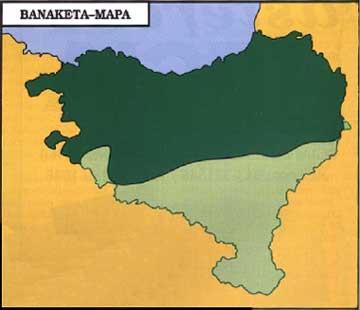
When we talk about amphibians, we always talk about the dependence of water on these animals and their need to live between the aquatic and terrestrial environment. Although these ideas are topical, they are often not very concrete and the species mentioned today is a clear example of this.
The common arrabio (Salamandra salamandra) is undoubtedly one of the driest amphibians in Europe in its general biology. Like the rest of amphibians, arrabio has a permeable skin, so the risk of dehydration is limited to live in arid environments. But in addition to this problem, we could say that the dependence of the animal on water is minimal, in the rest of aspects of its vital activity.
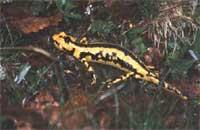
It is a beautiful animal that reaches a total length of 15 to 16 cm, being the largest urodelo of the Basque Country. Its head is longer than broad, dorsoventrally oppressed, and on the back of it, dorsolaterally situated, it presents clear parotoid glands. Black-brown eyes are also very noticeable in the dorsal part due to the excellent size of their orbits. Its trunk is cylindrical and its short arms and legs can hardly rise from the ground when they walk.
In the dorsal part, and as if it were a continuation of the parotoid glands, two parallel lines formed by nine bicorras from the side of the neck are displayed towards the isata. The tail is shorter than the body and its cross-section presents a rounded section, which indicates the dry character of the animal and its manifest inadaptability.
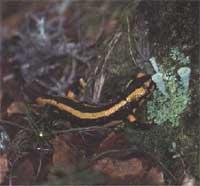
But the most significant descriptive trait of the arrabio is undoubtedly its striking beauty. The wet skin of the arrabio appears adorned with a yellow longitudinal spot and a shiny black, which makes the animal very popular for anyone who has passed through the mountain. Due to this peculiar coloration, the image of the arrabio has always been surrounded by several legends and beliefs, often considered as home to the kitchen of witches and demons. For example, in cultures across Europe there are plenty of legends that say the myrtle originated from fire or that it did not burn there. However, and returning to reality, the striking bright colors of the arrabio, of course, are right to be.
This animal, like most amphibians, is provided with poisonous surfaces. In the case of common arrabio, venom occurs in the dorsal dorsal dorsal dorsal dorsal lumps and in the parotoid brain glands, but also in the glands cells that develop intercalate along the entire epidermi, with a generally irritating skin. This poison is made up of substances from the alkaloid group Salamandarina, and if you had direct access to the blood of the enemies, you would have a great influence on them.
However, the poison of the arrabio has only a defensive function, so it will suffice with the mouth of the enemy that comes with the intention of eating with the stove, which will release it immediately. Therefore, when arrabio detects danger, the skin's glands cells secrete poison by immediately wetting the entire body with an irritating juice. In addition, the dorsal lumps and parotoid glands have the ability to launch the poison as a spray.
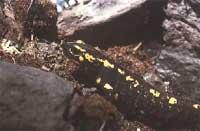
However, this peculiar defensive mechanism is formed by vivid superficial colors. And it is that although the poison causes the release of the arrabio by the enemy, the first bite can cause great damage to the animal, so it is necessary to avoid this first attack.
For this reason, the arrabio, like many amphibians of the tropics, claims its poisonous character through a vivid and eye-catching clothing, making this character known to all possible enemies, which is known as "aposematic" coloration. In any case, and in spite of this complex defensive mechanism, the arrabio has some enemy to which it seems that the poison does not affect them. Among them, stand out the urubia (Strix aluco) and the wild boar (Sus scrofa).
As has already been mentioned, arrabio is a particularly dry species and only approaches water to spawn larvae. Despite its nighttime and nightlife, rainy weather can also be seen during the day in search of insects, arachnids, miriápods, bazos and worms that are part of your diet. Although in general it is soloist, sometimes large groups have been seen, but we still do not know what is the cause of this fact.
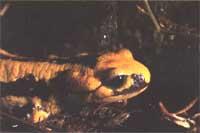
Unlike the rest of the urodelos of Euskal Herria, the arrabios fecundan dry. When the male meets a female, he first goes up, stopping like this. Then, and fastening with her arms to those of the female, she enters under her, and immediately begins to rub with the end the potato of the female, with the intention that it tightens her. After a few minutes the male releases a spermatophore to the ground, after which, curving 90º the trunk, lets the female fall on the spermatophore to receive it with thick spadaña. Through this system, the arrabiums have devised the way to carry out the internal fecundation in dry.
But probably the trait that best explains the terrestrial character of the arrabio is the ovibiparity of this animal. This type of reproduction is an obvious exception among the urodelos. In fact, arrabians tell us that they are on track to overcome the amphibious life cycle, divided into two different means. Fecundated eggs, instead of putting them in contact with water, remain in the ears of the female until the embryonic development is completed, even after hatching occurs.
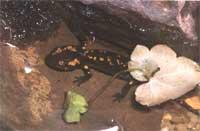
Finally, and when the larvae have an approximate length of 25 mm, the female gives birth in a well or river. These larvae are insatiable hunters and excellent swimmers who feed on small invertebrates that inhabit the water; at two or three months, when they have an approximate length of 5-6 cm. Once the metamorphosis is finished and already reached the appearance of adults, they land forever, hiding in the surrounding spots and mosses.
In spite of its marked terrestrial character, the arrabio needs humid and fresh environments to be able to live, so in the Basque Country it is, above all, in deciduous leaves of forest, being its main habitat the hayedo, the robledal and the mixed humid forest. As for the altitude, in the Basque Country it has been observed from the sea level to altitudes of 1 600 m, although in the Pyrenees it can reach the 1800-1900 m. However, most are in the mountainous stadium of the Euro-Siberian region.
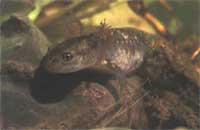
As for its geographical distribution, common myrtle is a species of paleoarctic region found in central and southern Europe, west of Asia and northwest of Africa. In the Iberian peninsula it can be said that it appears in all the north, while in the interior only appears in the mountains.
As for the Basque Country, it is common in most of the media of the Euro-Siberian region and in most of the transition mountains. In contrast, it is lacking in plains and arid areas of the south due to climatic conditions.
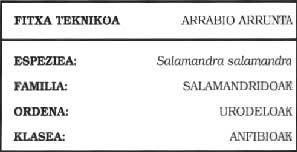
Buletina
Bidali zure helbide elektronikoa eta jaso asteroko buletina zure sarrera-ontzian











